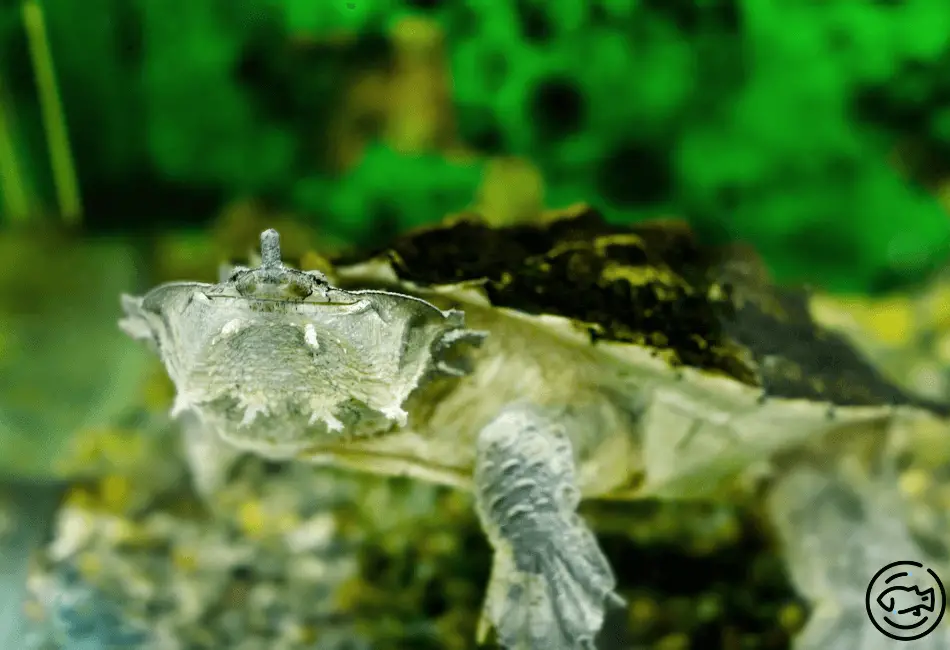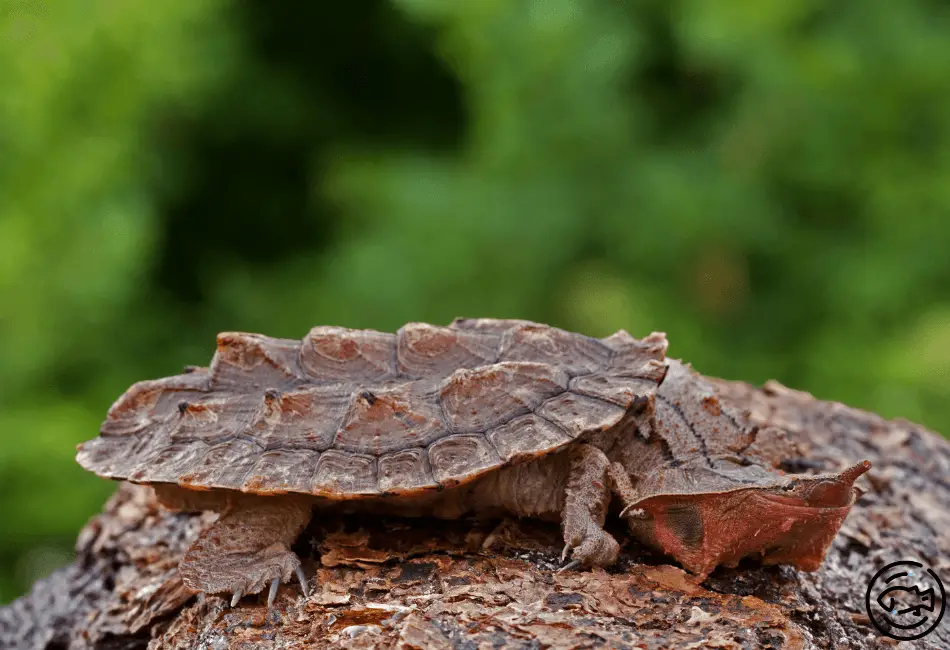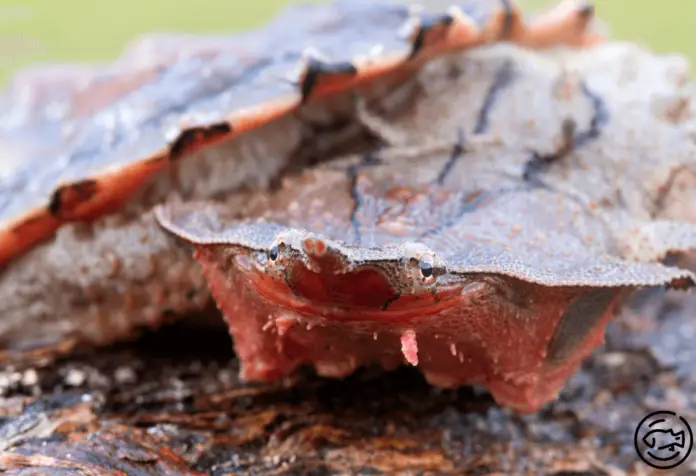The mata mata turtle, also known as the matamata turtle or mata-mata turtle, is a triangular-headed turtle from South America.
These turtles are sedentary freshwater creatures that require a substantial amount of space and appropriate water conditions. As such, they are not recommended for novice reptile keepers.
Scientifically named Chelus fimbriata, the mata mata turtle is commonly found in slow-moving backwater streams in South America, including countries such as Brazil, Peru, Venezuela, Ecuador, Bolivia, Colombia, and the Island of Trinidad. These turtles can develop up to 18 inches in size and have an average lifespan of up to 15 years.
Mata mata turtles are carnivorous and require specific housing conditions. They need a tank that measures at least 45×45 inches, with water temperatures ranging from 75 to 90°F, and slightly acidic water with a depth of 8 inches.
As an intermediate to expert-level species, keeping mata mata turtles requires significant knowledge and experience in reptile care.
Origin Of Mata Mata Turtle

The triangular-headed mata mata turtle (Chelus fimbriata) inhabits the slow-moving backwater streams, rivers, and swamps of South America, including Colombia, Peru, Brazil, Venezuela, Ecuador, and Bolivia, as well as the Island of Trinidad.
Despite being a strictly aquatic turtle species in the wild, mata matas are not proficient swimmers. They are more comfortable standing in shallow water enough to lift their snouts above the water’s surface and breathe air.
Appearance & Behavior

The mata mata turtle has a distinctive appearance that some individuals may consider unattractive. Its shell is rough, flat, and knobbed, and its neck’s skin is covered with grooves and lumps.
The mata mata turtle’s broad, flat head is triangular-shaped and features a long, snorkel-like snout.
The upper portion of the shell or carapace is dark brown, while the underside of the mata mata is yellow or brown. The turtle’s shell frequently has algae on it due to its lack of activity, which helps it blend in with its environment.
The legs, head, and tail of the mata mata turtle are covered in grayish-brown skin, and it has webbed feet with five claws on the front feet and four claws on the back feet.
Mata mata turtles have poor eyesight, so certain parts of their bodies act as sensory aids. The fleshy flaps on the head and neck’s sides have nerves that detect vibrations produced by potential prey.
Male mata mata turtles have concave undersides or plastrons and thicker tails than their female counterparts.
Nature
Mata mata turtles are stationary animals that lead solitary lives except during the breeding season. They infrequently swim and spend the majority of their time standing in shallow waters.
Mata matas enjoy their solitude, so although they are not territorial and typically display little aggressive behavior, it is recommended to house them separately.
If you are searching for a pet you can interact with, the mata mata turtle is not a good option. This turtle dislikes being removed from the water and can become aggressive.
Habitat Requirements
Young mata matas or hatchlings need a tank that can hold 60 gallons of water and have a water depth of 4 inches. These turtles grow rapidly, and as they mature, they need a tank that can hold around 100 to 150 gallons, mostly filled with water.
To accommodate adult mata matas, the tank should have a minimum of 10 gallons of water per inch of turtle. The water depth should be 10 inches, and the dimensions of the water body should be at least 48 inches in length and width.
Lighting
Proper lighting is critical for the healthy growth of mata mata turtles, as they require an adequate amount of light to thrive. Inadequate lighting can cause stress and lead to health issues in these reptiles.
To ensure that your mata mata turtle receives adequate lighting, it is essential to use a UVB bulb in the enclosure. The bulb should be replaced as needed, usually every six months.
For best results, position the light in the center of the vivarium’s roof to provide even illumination throughout the enclosure. Using a high-powered, compact fluorescent UV bulb is recommended, as it can effectively penetrate water.
Given that mata matas spend much of their time submerged, ensuring that the light reaches them is crucial.
To stay healthy, Mata matas need 10 to 12 hours of UVB light daily. Set the light on a 12-hour timer to provide a suitable day-night cycle.
Turn on the light during the day and switch it off at night to mimic natural conditions.
Temperature Requirements
To properly care for mata mata turtles, it’s essential to maintain a warm environment in their enclosure that replicates their natural tropical habitat.
While mata mata turtles don’t typically bask in the sun for long periods, a heat lamp is still a vital component of their tank. A heat bulb ranging from 75 to 150 watts, emitting temperatures between 93-97°F, should be placed about 12 inches above a dry basking area.
The water temperature and other areas in the enclosure, not directly beneath the heat lamp, should be kept between 75-85°F.
If the heat lamp in the basking area isn’t sufficient to heat the entire enclosure, a ceramic heat emitter or aquarium heater can be installed to maintain a consistent temperature, monitored using a thermometer.
Mata mata turtles don’t require special equipment such as misters to increase tank humidity. The warm, humid environment created by the water in the enclosure is typically enough to meet their needs.
Substrate Requirements
In order to create a comfortable and natural environment for mata mata turtles in their enclosure, it’s crucial to provide sandy or pebbly substrates that replicate their natural habitat. This will ensure the turtle has a comfortable surface to walk on.
However, it’s important to avoid using abrasive rocks or pebbles in the substrate, as these can cause injury or scrapes to the turtle’s underside.
Smooth-pebble gravel is a suitable alternative.
Despite devouring most of their time in the water, it’s still essential to have a dry spot in the enclosure for mata matas. You can achieve this by adding a smooth rock or a large log to the basking area or creating a basking island in the pond.
Aquatic and artificial plants can also provide hiding places for mata mata turtles, reducing stress levels. Deep-rooted plants like anubias and java fern are ideal for a mata mata enclosure.
Cleaning
Maintaining a clean environment for your mata mata turtle’s well-being and contentment is crucial. Since most of the enclosure is filled with water, keeping it clean entails regular water changes and filtration.
A large, robust filter is necessary to ensure that it can handle the tank’s size. Check the filter frequently, removing shredded skin or waste to prevent clogs.
Filtration should keep the water clean and eliminate waste, but you should still change the water regularly. Once a week, perform a partial water change by replacing one-third of the water in the tank.
Leaving the mata mata turtle in the enclosure is acceptable during water changes.
Every two weeks, inspect the tank for waste and shedded skin. If necessary, clean the basking area and wipe down plant leaves. However, this should be a fast job because mata matas spend little time on dry land.
Diet
In order to maintain the health and natural behavior of mata mata turtles, it’s essential to feed them a diet that mirrors their eating habits in the wild.
In their natural habitat, mata matas are carnivorous, feeding on fish, aquatic worms, and insects. Unfortunately, commercial turtle diets often lack nutrition and sustainability, so providing them with live prey is recommended.
Live prey that mata matas typically feed on include earthworms, guppies, minnows, goldfish, mollies, and muscles. When feeding mata matas, it’s important to note that they have weak jaws and can only consume prey that can be swallowed whole.
To prevent feeding struggles, it’s best always to provide around 40 food items spread throughout the enclosure.
Regarding feeding frequency, juvenile mata matas have a similar diet to adults. Ensuring that the live food is small enough to fit in their mouths is essential.
Young mata matas can be fed earthworms and feeder fish, such as guppies and mosquitofish.
As for the feeding process, mata matas are slow-moving creatures, so offering abundant food will allow them to feed freely. The tank should be topped up with live prey.
Common Health Problems
Mata mata turtles are prone to several health issues, which can easily be avoided by maintaining a healthy tank environment. Poor feeding and unsanitary tank conditions are the primary reasons for these problems.
Nutritional deficiencies
Nutritional deficiencies can cause mata matas to become inactive and affect growth rates. Therefore, feeding high-quality live foods that contain essential nutrients is necessary to prevent nutritional diseases.
Respiratory infections
Respiratory infections are expected when the tank is not humid or warm enough, and symptoms include swollen eyelids, mouth breathing, and a runny nose.
It’s crucial to consistently monitor the tank’s temperature using a thermometer to prevent respiratory infections.
Parasitic infections
Parasitic infections are prevalent among mata mata turtles due to their diet of live foods. Parasites, such as worms and amoeba, can cause vomiting, diarrhea, and weight loss.
A veterinarian should be contacted immediately to get antibiotic treatment for the turtle.
Shell trauma
Shell trauma is also common and can be caused by knocks, bumps, or scrapes.
Avoid steep climbing areas in the tank that the turtle could fall from, and avoid abrasive surfaces that can scrape the shell to prevent shell damage.
Supplements
Supplements can be given alongside a healthy and varied diet to promote the turtle’s health.
Vitamin D supplements help maintain healthy bones, skin, and shells, while calcium supplements prevent metabolic bone disease.
Vitamin A supplements help prevent vision problems and upper respiratory infections. Supplements should be added to the tank once a day or as the manufacturer advises.
Breeding
Mata matas reproduce and lay eggs during October and November in their natural habitat. They typically lay eggs in open, sandy areas and the eggs incubate for approximately 200 days before hatching.
Breeding mata mata turtles in captivity is a rare occurrence among hobbyists, mainly due to space limitations. The majority of individuals lack the adequate tank space to house a pair of mata matas.
Breeding mata matas requires specific knowledge and expertise, which is scarce amongst non-professional breeders. Therefore, it’s not recommended for them to attempt breeding these turtles without professional guidance.
Selecting and Purchasing a Mata Mata Turtle: Tips and Advice
In order to guarantee the health and well-being of a mata mata turtle, it’s essential to choose where to buy one carefully.
Reputable breeders or trusted online reptile stores are the best places to purchase a mata mata turtle, costing between $250 and $550.
While the mata mata turtle’s unique appearance makes it an attractive pet, it’s not widely available. Importing mata matas is legal, but captive-bred turtles are a better choice to avoid negative impacts on the species native habitat.
Before buying a mata mata turtle, inspect it in person to ensure it’s healthy.
Checking that the turtle has a rugged, smooth shell with no defects and examining the turtle’s head for clear eyes free of discharge or mucus is essential to ensure the turtle’s well-being.


